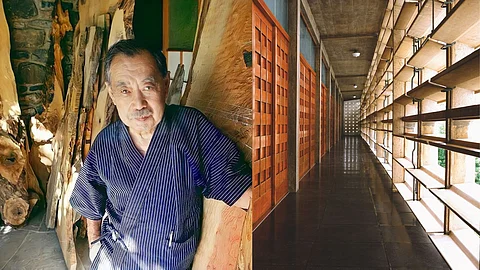
- HOMEGROWN WORLD
- #HGCREATORS
- #HGEXPLORE
- #HGVOICES
- #HGSHOP
- CAREERS
- ABOUT US
- CONTACT US

It's not surprising to see India's vast web of design connection with the world, one of which is the legacy of George Nakashima, the celebrated architect and furniture designer. This creative stands as a pillar through the lens of modernist aesthetics and the intricate artistry of woodwork. However, a lesser-known lens yet profoundly significant chapter of his career in shaping design ideologies unravels in India, where his work had a direct influence in the shaping of the architectural and design landscape in the area and the introduction of design concepts.
The year is 1950 and a correspondence between Nakashima and key Indian figures has started taking place, including Gira Sarabhai, an architect, a designer and the visionary director of the National Institute of Design in Ahmedabad at that time, and Udar Pinto, a disciple of Sri Aurobindo. These exchanges would forever intertwine Nakashima’s long journey with India’s spiritual and design evolution, adding layers to the conventional narrative of the cultural movement that plays a role towards the rejected traditional forms of expression in favour of new ways of conveying concepts' arrival in India.
Golconda, which is the name given to the building, stands as a testament to Nakashima’s groundbreaking work. It was not only an architectural milestone in concrete architecture in India but also a spiritual space—perfectly echoing and reflecting on the deeply spiritual ethos of Sri Aurobindo’s vision for modern India. Nakashima’s direction was as much about functionality and modernism as it was intertwined with spirituality throughout the construction, marking a turning point in how India perceived the merging of tradition and modernity.
Beyond the realm of architecture, Nakashima’s influence extended to the realm of design, where his approach to woodworking emphasized a deep connection with nature and materials. This philosophy found resonance and a direct connection with India’s rich history of craftsmanship, where we see how concepts such as the spiritual and the artisanal have always been intertwined and spoken about as one.
Nakashima’s relationship with India didn't end with the buildings he designed, but it extended to the spiritual ties he nurtured and learnt from the land. His work and correspondence with influential figures like Gira Sarabhai underscored his understanding of how design could transcend the material world, cast around the connection with the spiritual heart of India. His contributions — though often overshadowed by the iconic Charles Eames — represent a unique crisscross between modernism and spirituality, both crucial forces in shaping the post-independence cultural renaissance in India.
The life and work of George Nakashima are concepts to celebrate and embrace. We can understand the mutual and architectural influence on both himself and the fabric of India. His contributions continue to resonate today, underscoring the importance of understanding the connections between art, design, and the deeper meanings that transcend boundaries.
At the exhibition’s closing celebration, Vinay Desai’s soulful Santoor performance, accompanied by Pandit Samir Chatterjee’s tabla rhythms, echoed the timelessness of this dialogue between design, spirituality, and music. It was, indeed, a celebration of India’s vibrant, ever-evolving cultural landscape — a landscape that Nakashima deeply contributed to.
